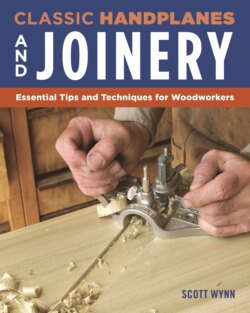Читать книгу Classic Handplanes and Joinery - Scott Wynn - Страница 15
На сайте Литреса книга снята с продажи.
Hardening, Tempering, and Annealing
ОглавлениеSteel’s hardness and ductility (the extent to which it can be stretched or bent without breaking) depends on its exact carbon-to-iron ratio and its thermal processing. Different temperatures are associated with different crystal structures, or phases, of the iron and carbon atoms. When steel with a carbon content above 0.4% (the minimum amount required for steel to harden) is heated beyond its critical temperature of around 750°C, it enters what is called the austenite phase. Austenite has a crystal structure that opens to allow the carbon atoms present to combine with the iron.
When austenite is cooled very quickly (by quenching), its structure changes to a needlelike crystalline form called martensite. Martensite locks in the carbon atom, hardening the steel. In this state, the steel is at its hardest, is under a great deal of internal stress, and is quite brittle. The more carbon the steel had to begin with, the more of it will be martensite and the harder it will be. As the carbon goes over 0.8%, however, the steel does not become any harder, but rather grows more brittle. In order for the steel to be useable as a blade, it must be softened to reduce the brittleness to a workable degree. This process is called tempering.
Tempering is a compromise, meant to balance hardness and ductility, and is definitely a judgment call made by the one doing the tempering, based both on experience and the intended use of the blade. To temper a blade, after hardening, the blade is reheated, this time to a lower temperature, perhaps 175°C (depending on the type of steel and the blade’s intended use), and quenched again.
There is a third process, done after the blade has been hot-worked to shape, but before hardening and tempering, and that is annealing. Here the blade is heated red-hot and allowed to cool without quenching. This softens the blade and removes stresses that may have resulted from its being hot-worked. Usually at this point, the blade is then ground to final (or near final) shape—easily done, since it is now soft—and then hardened and finally tempered.
At the other end of the hardness spectrum is carbide, used on power tool blades. Hard and brittle, carbide is unsuitable for the body of the tool blade because it would shatter. While carbide is extremely hard, the particles are also extremely large. Although they do not break off easily, when they do, they break off in clumps so big they are nearly visible to the naked eye. Carbide also cannot be made nearly as sharp as steel. A sharp steel saw or router blade cuts much more cleanly than a sharp carbide blade. Unfortunately, the steel dulls quicker than the carbide, especially when subjected to the glues in plywood and particleboard.
Hardness must be in balance with the intended use of the tool. For instance, high-impact hand tools, such as axes, should be softer than plane blades. Otherwise, the edge fractures quickly under the pounding an ax takes. The blades of fine tools for fine work can be very hard, but if their hardness exceeds the ability of the steel to flex without breaking at the microscopic edge, the tool will be next to worthless.
From Rockwell Hardness Measurement of Metallic Materials by Samuel R. Low, published by the National Institute of Standards and Technology, U.S. Department of Commerce
From Rockwell Hardness Measurement of Metallic Materials by Samuel R. Low, published by the National Institute of Standards and Technology, U.S. Department of Commerce
The Rockwell C (Rc) scale measures the hardness of woodworking blades. This is a unit of measurement determined by the impact of a ball-shaped point into the steel measured in terms of the depth of the resulting impression. The steel in a common grade of handsaw measures around 46–48 Rc, with high-quality Disston saws (at their peak when Disston still owned them) measuring 52–54 Rc. Harder yet, Japanese saws are roughly in the 50–58 Rc range; this is on the cusp of what a file will cut. Decent plane and chisel blades are in the range of 58–66 Rc range—though I would expect a good quality plane blade to be at least 60–62 Rc. Only some finely wrought steels work effectively in the upper-half of this range, principally high-quality hand-forged Japanese blades, and some high-alloy steels. In carbon steels, 66 Rc seems to be a limit above which the edge breaks down too rapidly in use.
FIGURE 1-1. The polished bevel on a cast steel blade reveals the lamination of the backing steel and the cast steel; the color difference is where the two are forge-welded together.
FIGURE 1-2. The color line on the back of this old unpolished rabbet plane blade shows right where the piece of cast steel leaves off and the backing steel takes over for the rest of the blade.
